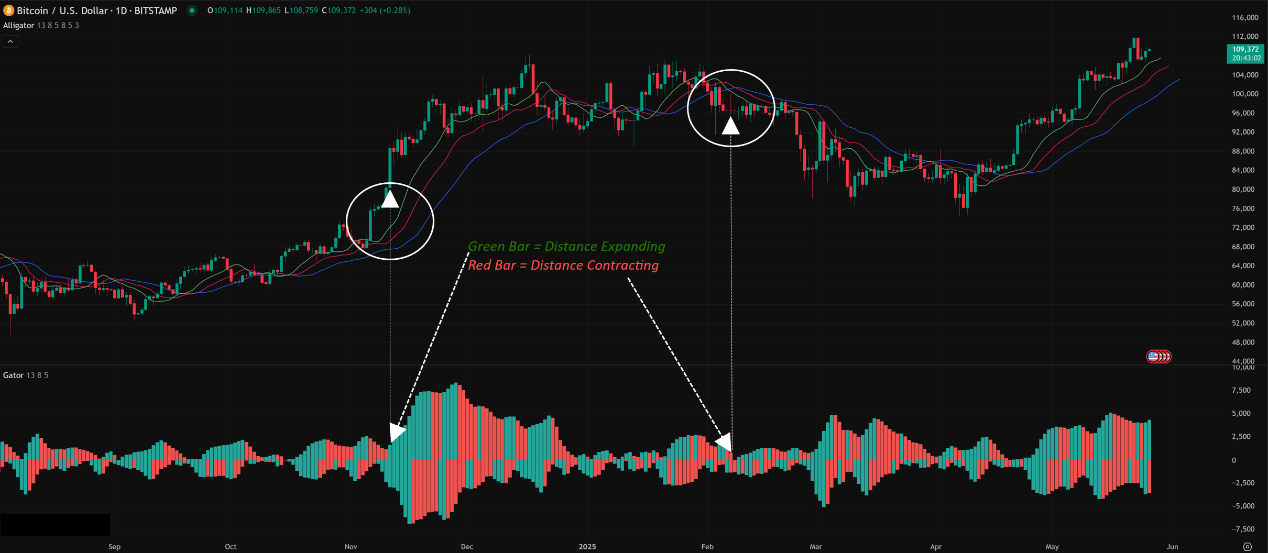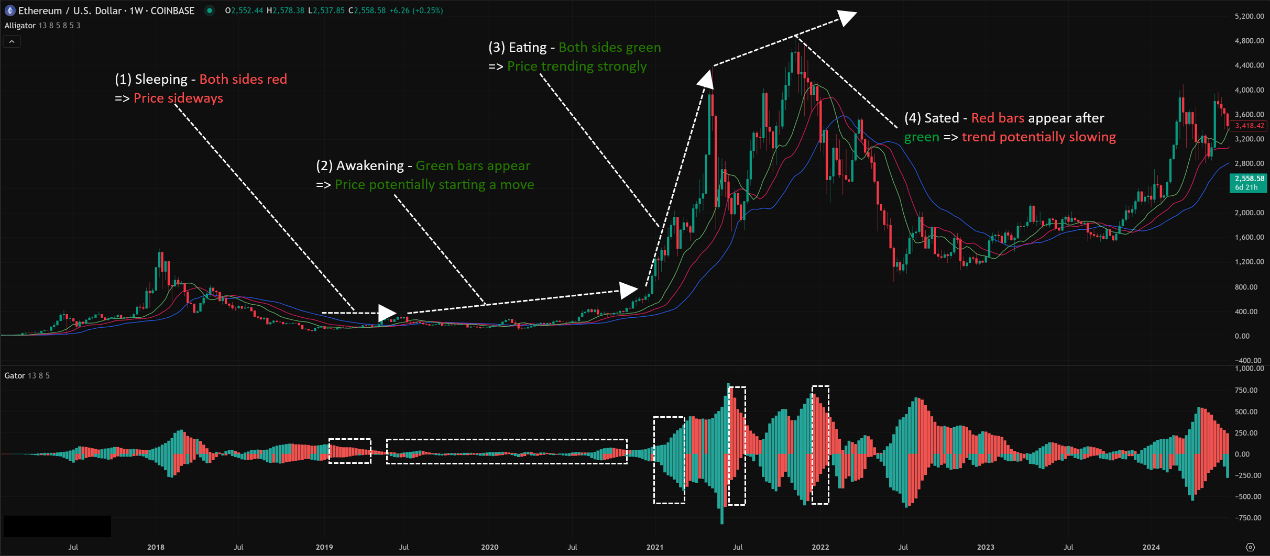Physical Address
304 North Cardinal St.
Dorchester Center, MA 02124
Physical Address
304 North Cardinal St.
Dorchester Center, MA 02124
Okay Okay! What’s up, future stars of the Crypto and Finance world! It’s time again to deep-dive into another technical indicator! Last time we broke down Standard Deviation, today we’re playing with something even more interesting and ‘visual’ – the Gator Oscillator!
Sounds kinda wild, right? Exactly! The creator, Bill Williams, wanted to use the vivid analogy of an ‘alligator’ to help us see through the different states of the market. It doesn’t just help you judge the trend, it tells you when the trend is ‘sleeping,’ ‘waking up,’ ‘eating,’ and ‘full’! Wanna know how to use this ‘gator’ to hunt for profits in the market? Follow along as we dissect it from basic to advanced! Ready? Let’s get this bread!
The Gator Oscillator doesn’t really stand alone. It’s actually the ‘visual assistant’ for another indicator invented by the legendary trader Bill Williams – the Alligator indicator.
Daddy is the Alligator: In his “Trading Chaos” series of theories, Bill Williams introduced the Alligator indicator. The Alligator consists of three moving averages with different periods and offsets (named the ‘Jaw,’ ‘Teeth,’ and ‘Lips’), used to determine market trends and direction. He believed the market is trendless most of the time (the alligator is sleeping), and only trends significantly for short periods (the alligator wakes up to hunt).
Gator’s Purpose: While the Alligator indicator is useful, sometimes the three lines get tangled up, making it hard for beginners to clearly see if they’re starting to spread apart (trend forming) or converge (trend weakening). So, Bill Williams designed the Gator Oscillator to directly graph the ‘changing distance’ between the Alligator’s lines! Think of the Gator as the Alligator’s ‘EKG’ (electrocardiogram), telling you exactly how active the gator is right now.
So, the Gator Oscillator was created to make the Alligator’s status crystal clear, helping traders more easily capture the market cycle from ‘resting’ to ‘activating’ to ‘exhausting.’
The Gator Oscillator is actually a dual histogram displayed below the main price chart. How’s it calculated?
Based on the Alligator: First, you need the Alligator indicator on your chart (if your platform doesn’t have it built-in, the standard parameters are usually: Jaw=13-period SMA, shifted 8; Teeth=8-period SMA, shifted 5; Lips=5-period SMA, shifted 3).
Calculate the Distance Between Two Lines:
Upper Bars (Positive Value): This is the absolute difference between the Alligator’s Jaw (blue line) and Teeth (red line). This bar shows how wide the ‘jaw’ and ‘teeth’ are opening.
Lower Bars (Negative Value): This is the absolute difference between the Alligator’s Teeth (red line) and Lips (green line), but it’s plotted as a negative value below the zero line. This bar shows how wide the ‘teeth’ and ‘lips’ are opening.
The Color Secret (The Color Code): This is the most crucial part of the Gator! The color of each bar doesn’t depend on its value, but on whether its value (absolute value) is bigger or smaller than the previous bar:
Green Bar: Means the absolute value of this bar is greater than the previous bar. This indicates the distance between the corresponding Alligator lines is expanding (The gator is opening its mouth!).
Red Bar: Means the absolute value of this bar is less than the previous bar. This indicates the distance between the corresponding Alligator lines is contracting (The gator is closing its mouth!).
Simply put, the Gator Oscillator uses ‘distance’ and ‘color’ to tell you the Alligator’s four states:
Gator Sleeping: Both upper and lower bars are Red (or sometimes grey/absent depending on the platform). Means the Alligator lines are intertwined, distances are contracting, the market is directionless, no trend.
Gator Awakening: Bars on top and bottom have different colors (e.g., one red, one green), or Green bars start appearing after all Red. Means the Alligator lines are starting to diverge, a trend might be forming.
Gator Eating: Both upper and lower bars are Green! Means the Alligator lines are spread wide apart, the distance is continuously expanding, the trend is established and strong!
Gator Sated (Full): Red bars start appearing after the ‘Eating’ phase. Means the distance between Alligator lines is starting to contract, the trend might be weakening, pausing, or preparing to reverse.
「Gator Oscillator Structure & Color Explanation」

Level 1: The Textbook Basics (The Basic Phases)
The most fundamental way is to follow Bill Williams’ script, using the Gator to identify the four market phases and act accordingly:
Gator Sleeping (All Red / All Grey):
Market State: Sideways, directionless, low volatility.
Action: Stay Out! Bill Williams emphasized not trading when the gator is sleeping because there’s no trend, and you’re likely to get whipsawed by random market noise. This is the time for patience, wait for an opportunity.
Gator Awakening (Mixed Red/Green / Green Appears):
Market State: Volatility starts picking up, the old trend might be ending, a new trend could be brewing.
Action: Start paying attention, prepare for entry. This phase is a potential turning point. You can start looking for entry signals (e.g., using Bill Williams’ Fractals indicator for breakout points).
Gator Eating (All Green):
Market State: Trend confirmed! And it’s strong! (Whether up or down).
Action: Hold On to Your Position! If you entered earlier, this is the phase to sit tight and let profits run. If you missed the entry, chasing the trend here is riskier, but the direction is confirmed. Bill Williams advised trading with the ‘Eating’ direction.
Gator Sated (Green Turns Red):
Market State: Trend momentum is starting to fade. It might be entering a correction, consolidation, or preparing for a reversal.
Action: Consider taking profits / tightening stop-loss. When the Gator starts showing Red bars, the gator might be full, and the trend’s strength is diminishing. It’s time to think about locking in some profits or moving your stop-loss closer to protect existing gains.
Remember: The Gator doesn’t give direct buy/sell points; it tells you the market’s ‘rhythm’ and ‘energy state.’
「Gator Oscillator Four Phases Example」

The Gator looks simple, but how do you play it like a pro?
A. Parameter Settings (Parameters) Deep Dive:
Default Parameters: The Gator itself doesn’t have independent parameters; its parameters are entirely inherited from the Alligator indicator. Bill Williams’ standard Alligator parameters are:
Jaw Period: 13 (Blue line)
Jaw Offset: 8
Teeth Period: 8 (Red line)
Teeth Offset: 5
Lips Period: 5 (Green line)
Lips Offset: 3
(Note: Periods use Smoothed Moving Averages – SMMA, Offset shifts the line into the future)
Why These Numbers? The 13, 8, 5 chosen by Bill Williams are Fibonacci Numbers, which he believed resonate with the market’s natural rhythms. The Shifts (Offsets) are intended to make the Alligator lines better represent future balance points.
How Traders Around the World Play It (Global Variations & Styles):
The Strongest Consensus: Don’t Mess With It! Bill Williams’ trading system (Profitunity / Trading Chaos) is a holistic system. The Alligator, Gator, Fractals, Awesome Oscillator (AO), and Accelerator Oscillator (AC) are designed to work together. Most serious followers of Williams’ methods (found across the US, EU, and globally) insist on using the default parameters. They believe changing them disrupts the internal synergy of the entire system.
Experimental Adjustments (Minority View): Some traders might experiment with fine-tuning the Alligator parameters for specific markets (like highly volatile crypto) or specific timeframes (like ultra-short-term scalping), perhaps using a faster combo like 8, 5, 3. This would naturally make the Gator react faster, becoming more sensitive to short-term volatility.
Example: Certain crypto scalpers might use a faster Alligator/Gator combo on an M5 chart to catch micro-trend initiations, but they accept the increased risk of noise and false signals.
The Bottom Line: Unless you deeply understand the entire Bill Williams philosophy or have done extensive backtesting, it is strongly recommended to use the default parameters (13, 8, 5). Changing them randomly is like taking parts from an F1 car and putting them together haphazardly – the result might be worse.
B. The Impact of Timeframes:
How the Gator behaves is highly dependent on the timeframe you’re watching:
Short Timeframes (M1, M5, M15): The Gator will be very ‘active,’ switching between the four phases rapidly. Many short ‘Sleeping’ and ‘Awakening’ states occur. You might catch quick scalps, but there’s lots of noise, and trends lack persistence. Suitable for experienced scalpers.
Medium Timeframes (M30, H1, H4): Phase transitions are clearer and can last for a decent duration. The ‘Eating’ phase trends are more reliable. Good for Day Trading and Swing Trading. Many Williams followers use H1 or H4 as their primary trading timeframe.
Long Timeframes (D1, W1): Gator phase transitions are very slow. An ‘Eating’ phase might last weeks or even months. You’re seeing the state of the major, macro trend. Suitable for long-term positioning and determining the big picture.
C. Which Combos Are “Hot” & Effective? (The “Synergy” Combos)
Again: No “Holy Grail.” But the Gator Oscillator isn’t designed to be used in isolation. Its power lies in synergy with other Bill Williams indicators.
Combo 1: “Alligator + Gator + Fractals” Entry Method (The Classic Williams Entry)
Indicators: Alligator (13,8,5), Gator Oscillator, Fractals
Timeframes: H1, H4, D1
Logic: Use Gator to judge market state, Alligator for trend direction, and Fractals for specific entry points.
How to Use:
Wait for the Gator to Sleep (Gator all red).
Wait for the Gator to Awaken/Eat (Green bars appear, Alligator lines start spreading).
Find the Fractal Breakout:
If Alligator lines spread upwards (bullish), wait for price to break above the most recent Up Fractal.
If Alligator lines spread downwards (bearish), wait for price to break below the most recent Down Fractal.
Entry Condition: At the moment of the Fractal break, the Gator should ideally be in the ‘Eating’ phase (all green), or at least the ‘Awakening’ phase (showing green). Absolutely do NOT enter during the ‘Sleeping’ phase!
Effectiveness: This is one of the core entry methods of the Bill Williams system, designed to catch trend initiations while using the Gator to filter out low-probability sideways markets. Many followers worldwide use this logic.
Combo 2: “Gator + AO/AC” Momentum Confirmation
Indicators: Gator Oscillator, Awesome Oscillator (AO), Accelerator Oscillator (AC)
Timeframes: Match your trading timeframe
Logic: AO shows market momentum, AC shows the acceleration of momentum. Use Gator for trend state, and AO/AC to confirm if momentum agrees.
How to Use:
When Gator enters the ‘Eating’ phase (all green), if AO is simultaneously above zero (uptrend) or below zero (downtrend), and its color (usually green for up, red for down) matches the trend direction, it signifies the trend has momentum backing it.
AC can provide even earlier signals. For example, while Gator is still ‘Awakening,’ if both AO and AC show consecutive green bars (uptrend) or red bars (downtrend) in the same direction, it could be a more aggressive entry signal.
Effectiveness: Adds a layer of confirmation to trade signals, helping avoid chasing trends that lack underlying momentum.
D. What Are the Best Parameter Combos? (The “Best” Settings Revisited)
For the Gator Oscillator, the answer to this question is simpler than for many other indicators:
In the vast majority of cases, the “best” parameters are simply the default Alligator parameters (13, 8, 5).
Why?
System Integrity: Gator is part of the Williams system, designed for perfect synergy with the default Alligator.
Philosophical Core: Changing parameters might contradict Bill Williams’ understanding of market chaos and fractal structures.
Proven Practice: A large community of Bill Williams followers has traded successfully using the default parameters for years.
If You Absolutely Must Experiment:
Master the Default First: Don’t change anything until you fully grasp Gator’s behavior with standard settings.
Make Minor Adjustments Only: If you’re trading something with extremely different volatility than traditional markets (e.g., certain altcoins) or using extreme timeframes (M1), you could consider slightly tweaking the Alligator parameters (e.g., 8, 5, 3), but only after extensive backtesting.
Understand the Consequences: Faster parameters increase noise; slower parameters increase lag.
Key Takeaways on Parameters/Timeframes:
Parameters: Strongly advise sticking to the defaults (13, 8, 5 for Alligator).
Timeframes:
Scalping (M1-M15): Noisy, fast phase changes.
Day/Swing Trading (M30-H4): Clearer phases, commonly used.
Position Trading (D1+): Macro trends, long-lasting phases.
Combinations: Gator + Alligator + Fractals is the core entry strategy. Gator + AO/AC provides momentum confirmation.

The Gator Oscillator might not be the most famous indicator, but it’s definitely a gem for Bill Williams fans and traders seeking a deeper understanding of market ‘states.’ It acts like a translator, turning the complex interplay of the Alligator lines into a simple, understandable four-act play: Sleeping, Awakening, Eating, Sated.
It helps you:
Visualize Alligator’s State: See at a glance if a trend is brewing, ongoing, or fading.
Filter Trading Times: Emphasizes patience during the ‘Gator Sleeping’ phase, avoiding trades in trendless markets.
Confirm Trend Strength: The ‘Eating’ phase (all green) is the strongest trend confirmation.
Trade Systematically: Forms part of a complete trading logic with Alligator, Fractals, AO, and AC.
For young traders aiming to find a consistent rhythm in the volatile worlds of crypto and finance, learning to use the Gator Oscillator is like gaining a tool to ‘listen’ to the market’s breathing. It reminds you when to lie low, when to strike, and when to pull back.
Remember:
Gator is an assistant to the Alligator, not a standalone indicator.
Sticking to default parameters is usually the best approach.
Its real power comes from using it within the broader Bill Williams toolkit.
Hope this breakdown helps you tame this ‘market gator’! Go ahead, add it to your charts and observe how it paints the market’s ebb and flow! See you next time! Keep grinding!